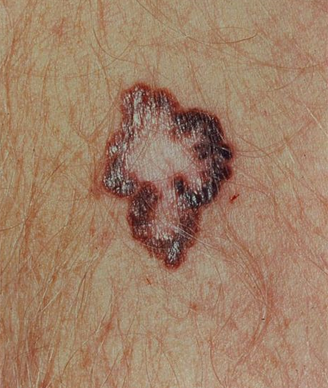Combination of BRAF and PI3K Inhibitors Explored in Melanoma
Cutaneous melanoma

Preliminary data from a combination trial of vemurafenib plus PX-866, a nonreversible pan-PI3 kinase inhibitor were presented at the 10th International Congress of the Society for Melanoma Research (SMR) held in Philadelphia. The patient cohort included 19 patients with metastatic melanoma and a single patient with gastrointestinal stromal tumor-all patients had either V600E or V600K BRAF-positive disease.
Patients were treated with various combination doses in 28-day cycles.
The phase I/II clinical trial is still accruing patients, said presenter Tara C. Gangadhar, MD, assistant professor of medicine at the Abramson Cancer Center at the University of Pennsylvania Medical School in Philadelphia.
The overall response in the melanoma patients was 53% (10 of 19).
Responses were seen both in patients who had not been previously treated with a BRAF or MEK inhibitor and in patients whose cancer progressed following either a BRAF or MEK inhibitor. Thirty-five percent of patients (7 of 20) had previously been treated with either a BRAF or a MEK inhibitor. Of these, three patients had either a partial response or stable disease to the vemurafenib plus PX-866 combination, with two of these patients continuing to respond in cycle 10 and 13 of therapy, said Gangadhar.
“The combination appears tolerable, but we still have to do expansion at the maximum tolerated dose to confirm tolerability,’’ said Gangadhar.
Dose-limiting toxicities were experienced in two of the patient cohorts: both the group treated with 960 mg vemurafenib twice daily plus 6 mg of PX-866 daily (960/6) and the group treated with 960 mg vemurafenib twice daily plus 8 mg PX-866 daily (960/8).
A dose of 8 mg PX-866 as monotherapy was previously found to be the maximum tolerated dose. One patient in the five-patient cohort treated at the 960/8 dosage schedule experienced grade 3 pancreatitis and another had asymptomatic grade 3 lipase elevation. Of the eight patients treated at the 960/6 dosage schedule, one had a grade 3 rash and other patients had high-grade gastrointestinal toxicities and arthralgia.
Because patients on both of these dosage schedules had to have reductions in their vemurafenib dose, the trial is now enrolling another cohort, testing 720 mg of vemurafenib twice daily in combination with 8 mg of PX-866 daily. Thus far, one patient has been enrolled into this cohort, and the goal is to enroll two more. Then, if there are no dose-limiting toxicities, the cohort will be expanded to up to 20 more patients, said Gangadhar.
Of the ten patients treated at the 960/6 dosage schedule, one had a complete response, six had a partial response, and two patients had stable disease. The patients who had either a complete or partial response remain active in the study. Of the five patients treated at the 960/8 dosage schedule, four had stable disease.
Sixty-two percent of the patients (8 of 13) who had not previously received treatment with either a BRAF inhibitor or a MEK inhibitor responded to the novel combination.
Researchers involved in the trial are assessing patients’ tumors biopsies prior to treatment for mutations and aberrations that may predict response to the BRAF and PI3 kinase inhibition combination and identify any resistance mutations from prior therapies.
“Many patients have a very short duration of response with a BRAF inhibitor or the combination of BRAF plus MEK inhibition. We need to understand whether there are patients who may benefit more from BRAF plus PI3K inhibition,” Gangadhar told Cancer Network.
Both longer follow-ups of these patients as well as additional larger studies are needed to understand whether this combination could overcome resistance to monotherapy treatment with a BRAF or MEK inhibitor, and to find out whether this combination could result in durable responses when given to patients as a first-line metastatic treatment.